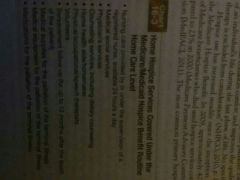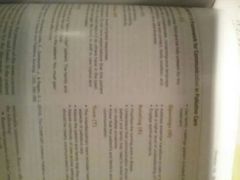![]()
![]()
![]()
Use LEFT and RIGHT arrow keys to navigate between flashcards;
Use UP and DOWN arrow keys to flip the card;
H to show hint;
A reads text to speech;
29 Cards in this Set
- Front
- Back
- 3rd side (hint)
|
Hospice care services under medicaid |

Page 380 med surg |
|
|
|
Nurses can assist patients and caregivers in what way? |
Life review, values clarification, treatment decision making, end of life goals. |
|
|
|
Advance directives |
Written documents that allow the individual of sound mind to document preferences regarding end of life care. |
|
|
|
Durable power of attorney |
A legal document through which the signer appoints and authorizes another individual to make medical decisions on his or her own behalf. Different than power of attorney. |
|
|
|
Living wil, |
A type of Dance directive in which the individual documents treatment preferences in case the signer is terminally I'll and not able to communicate her wishes. |
|
|
|
Patient self determination act |
Health care entities agencies using medicare or medicaid must ask patients if they have an Dance directive, provide info on advance directives, and incorporate advance directives into the medical record. |
Medicare |
|
|
Nurse can get comfortable with the subject of dethroned by doing the following |
Values clarification and personal dethroned awareness excercises, speaking get with friends and family. Learning how other cultures deal with death and dying. |
|
|
|
What method is best when communicating a life threatening illness or disease progression |
Interdisciplinary team. Physician, nurse,social worker chaplain. |
|
|
|
COMFORT acronym for what |
Communication, Orientation, Mindfulness, Family, Openings, Relating, Team |

PGA 383 med surg |
|
|
Dyspnea how to relieve pharmacologic and non pharmacologic ways |
Morphine relieves dyspnea, guided imagery reduces anxiety. Minimum dose do For the right effect and avoid multiple medications. |
|
|
|
Pain medicene..end of life |
Oral, if can't swallow rectal or sublinguil. Around the clock pain meds. Person may die near that time e. Assure family they did not cause the death. |
|
|
|
Anorexia-cachexia syndrome |
Disturbances in carbohydrate, protein, and fat metBolism; endocrine dysfunction; and anemia. Results in severe as the Niagara (loss of energy) supplementing with parental feedings does not replenish lean body mass that has been lost. |
|
|
|
Pharmacologic agents to stimulate appetite |
Decadron, megace, marinol. Therapy should discontinue after 4 to 8 weeks. Decadron initially increases appetite and provide short term weight gzin. Use in patient with less than 6 weeks. Megace produces weight gain of fatty tissue. It takes time to see results should not be used if life expectancy is less than 30 days. Marinol reduces nausea vomiting also lessens anxiety. |
|
|
|
Cachexia |
Severe muscle wasting and weight loss related to illness. |
|
|
|
Promoting nutrition in terminally I'll patients |
Offer small portions Cool foods are better tolerated the hot foods. Offer cheese, eggs, peanut butter, mild fish, chicken or turkey. Beef may taste bitter. Add milk shKes, meal replacement drinks place nutrient foods at bedside Schedule meals with family members Offer ice chips made from frozen fruit juices Allow patient to refuse food and fluids |
|
|
|
Treating delirium |
Haldol to decrease hallucinations Benzodiazepines to reduce anxiety Identify the underlying cause Reduce stimuli. Avoid harsh lighting and dim lighting which can cause shadows. |
|
|
|
Signs of death |
Less interest in eating or drinking Urinary output decreases Patient will sleep more, detach from environment Mental confusion becomes apparent Vision and hearing become somewhat impaired Secretions may collect at the back of the throat Breathing becomes irregular with periods of no breathing Patient may become restless as oxygen to the brain decreases Patient may become hot one minute than cold the next due to body's inability to control internal temp Loss of bladder function Patients may report seeing things |
|
|
|
Medication to reduce secretions |
Atropine ophthalmic Glycopyrrol late Scopolamine patch |
|
|
|
5 stages of grief |
Denial Anger Bargaining Depression Acceptance |
|
|
|
Complicated grief |
Characterized by prolonged get feeling good of sadness and feelings of general worthlessness or hopelessness that persist long after death. |
|
|
|
Actual loss |
Recognized by others as well as the person sustaining the loss (loss of limb, loss of a child) |
|
|
|
Perceived loss |
Loss of youth, financial information dependence, valued environment experienced by the person but I tangible to others. |
|
|
|
Maturational loss |
Loss when natural development happens. Parent feels loss when child enters schoo, |
|
|
|
Situational loss |
Result of unexpected event natural disaster traumatic injury death. |
|
|
|
Anticipatory loss |
Person displays loss and grief behaviors for a loss that has yet to happen |
|
|
|
Stages of grief |
Shock and disbelief Developing awareness Restitution Resolving the loss Idealization Outcome |
|
|
|
Anticipatory grief |
Phase in which patients (parents) gradually incorporate the reality of their (child) fate into their thought. MAY LEAD TO PARENTS DISTANCING FROM THEIR CHILD TOO SOON. |
|
|
|
Vulnerable child (fragile children) |
when a child does not die but a parent has shut them out. They may develop behavior problems. |
|
|
|
Autopsy In a child |
If a child's death occurs within 24 hours of admission an autopsy is required. |
|

